Recently, Federal introduced a new self-defense pistol chambering, the 30 Super Carry. Some may wonder why we need another cartridge, especially when we cannot obtain older cartridges in the quantity and price we need. As a partial answer, the 30 Super Carry is intended to up the ante in power, energy, velocity, and penetration over the 380 ACP. On the other hand, it is intended to perform as closely to the 9mm as possible, with lighter recoil and more rounds in the magazine. We wanted to see if the 30 SC is a neat trick that we could recommend to Gun Tests readers, or is the new round just tricky marketing.
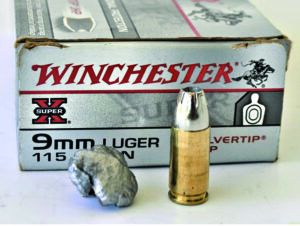
Of course, the 380 ACP and 9mm Luger are well established as self-defense rounds. Compared head to head, the 9mm Luger offers considerable improvement in terminal ballistics over the 380 ACP and is our most widely distributed defense caliber. As such, it is the cartridge for the 30 SC to beat based on performance. On the other hand, for some, recoil is a real concern. So is gun handling and racking the slide efficiently, two aspects where the 9mm Kurz, aka the 9mm Short or 380 ACP, excels. So for those shooters, would the 30 Super Carry offer a viable alternative? To get some data on both comparisons, we looked at the 380 ACP, 9mm Luger, and 30 Super Carry in three nearly-identical Smith & Wesson Shield EZ Rack pistols. We say nearly identical because the markings and weights varied only slightly between the handguns. For all practical purposes, the handguns themselves were identical. We fired them head to head at the range, comparing accuracy and recoil control. We also fired the three calibers in ballistic testing. The difference in sights, handling, and the triggers were minimal. The primary differences were in recoil and bullet performance in water jugs to assess effectiveness on physical targets. Here’s what we found:
Gun Tests Grade: A-
$400
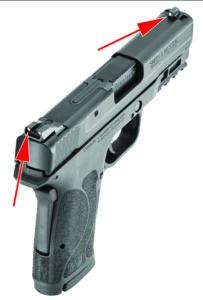
Recoil is a concern for some shooters, so this Smith & Wesson Shield EZ is a 380 ACP pistol large enough to be a joy to fire. Racking the slide is also a concern for some. Smith & Wesson designed this pistol to be easy to operate and load. Because trigger control can be a chore with striker-fired double-action-only handguns, Smith & Wesson designed the Shield 380 EZ as a single-action type. While the single action makes sense, there are drawbacks to be addressed as well. This pistol features an internal hammer. As such, when the slide is racked, the hammer is cocked. To make the pistol safe to carry, the Shield features a positive firing-pin block and also a grip safety that blocks the trigger. This grip safety is very easy to use. Simply grasp the pistol as you draw, and as you line up the target, completely depress the grip safety. The result is a nice single-action trigger press in a natural motion. Smith & Wesson offers also offers a version with a manual safety (No. 11663), but we chose one without the safety lever because we wanted to see how the pistol sans lever work, but also because the type with a manual safety was subject to a safety recall a couple of years ago. So, we cannot comment on function of the No. 11663 model with a manual safety lever, but be certain to listen when a company makes a safety recall. Some prefer a manual safety, some do not. Smith & Wesson offers each.
| Action Type | Semi-auto single action, internal hammer fired |
| Overall Length | 6.7 in. |
| Overall Height | 4.85 in. |
| Maximum Width | 1.16 in. |
| Weight Unloaded | 18.5 oz. |
| Weight Loaded | 21.0 oz. |
| Slide | Armornite-finished stainless steel |
| Slide Retraction Effort | 9.5 lbs. |
| Frame | Textured black polymer, 3-slot rail; 18-degree grip angle |
| Front Strap Height | 2.15 in. |
| Back Strap Height | 2.95 in. |
| Grip Material | Textured black polymer |
| Grip Thickness (Maximum) | 1.0 in. |
| Grip Circumference (Maximum) | 5.1 in. |
| Barrel | 3.675 in.; stainless steel, Armornite finish, tactile loaded-chamber indicator |
| Magazines | (2) 8-rd. detachable boxes |
| Trigger Pull Weight | 4.75 lbs., tactile and audible reset |
| Trigger Span | 2.6 in. |
| Safety | Grip |
| Front Sight | Fixed post, white dot |
| Rear Sight | Windage adjustable, two white dots |
| Sight Radius | 5.8 in. |
| Safety | Ambidextrous safety and grip safety |
| Warranty | Limited lifetime |
| Telephone | (800) 331-0852 |
| Website | Smith-Wesson.com |
| Made In | Springfield, MA |
Let’s address how Smith & Wesson handled the issue of racking a slide with less effort than is usually needed. After all, no matter how easy to fire and use, a pistol at some point must be loaded and unloaded. The Shield EZ requires about 9 pounds of effort to rack the slide, which is light by any standard. As an example, a Walther PPK on hand demanded 12.5 pounds of effort to rack. Most 9mm pistols require about 16 pounds of effort to rack.
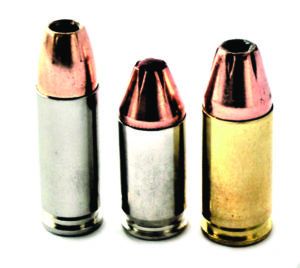
With the leverage and balance in length between the slide and handle, this pistol is quite easy to handle well. S&W went to a lighter recoil spring and a lighter hammer spring. This is possible because the pistol is chambered in 380 ACP. There isn’t a lot of pressure required to contain the energy of the 380 ACP, which typically pushes 95-grain bullets at 950 fps. The recoil spring may be lighter, and the hammer spring may be light as well because the slide doesn’t need much energy to cock the hammer. A 9mm could not be this light and easy to manipulate. The Smith & Wesson EZ pistol solves a lot of problems for shooters. We found the Smith & Wesson Shield 380 EZ to be a remarkably easy handgun to manipulate and use. There is more to it than that, however, because the pistol also features magazines that are easily loaded. The pistol is supplied with two magazines. A special extension on the follower of the all-steel magazine gives the shooter plenty of leverage to push down the magazine spring.

If we were picking a handgun for an accomplished shooter, we might choose another handgun, but the Smith & Wesson 380 Shield EZ is appealing to the shooter who needs a little help. Many people will have difficulty shooting and handling a full-size 9mm because the recoil spring must be rated to handle the heaviest loads. The recoil spring is compressed as the slide is racked in recoil. A weak spring may invite short cycles. So, the 380 ACP seems ideal for the person who has difficulty racking a slide. Just the same, we wanted to be certain that the Smith & Wesson Shield 380 EZ is reliable with all loads, so we used one of the heaviest 380 Auto loads we know of, the Federal 99-grain HST. It worked just fine in the Smith & Wesson. The round did not function well in a Walther PPK. When firing the Shield with the heavy HST load, recoil was little different than with standard loads, which is something of a feat to accomplish. Some gun-shop salesmen cannot seem to understand that everyone isn’t the same. A shooter needs a handgun that will suit his or her physical needs. The pistol should be tailor made for them, and they should not have to step up and handle a handgun that is too difficult for them to manipulate. Otherwise, they might not be armed at all, and be unprotected.
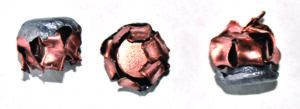
Smith & Wesson did not have to design this piece from scratch. The Smith & Wesson Military & Police Shield 380 EZ is based on the Smith & Wesson Military & Police 22-caliber pistol. The barrel and other key parts differ, but the outside dimensions are very similar. However, there are certain additions, including what Smith & Wesson calls the 2.0 improvements. The cocking serrations are well done and make racking the slide easier. The pistol features both forward and rear cocking serrations. The frame is nicely textured for fit and feel and gets high ratings on both adhesion and abrasion. The treatment doesn’t abrade the hand, but it provides good purchase. The frame is slanted at the backstrap at an 18-degree angle. This provides a good fit for almost any hand size. The human engineering of the pistol is excellent. When grasping the pistol to fire, our shooters expended no noticeable effort to close the grip safety and keep it closed. Yet as soon as we relaxed the grip, the pistol-grip safety returned to the Safe position. This is a good design.

The all-steel magazines feature an extension of the follower that is manipulated to move the follower to the bottom of the magazine and load the magazine. While all pistol magazines are more difficult to load toward the last of the cartridge stack, the Shield 380 ACP magazines were never difficult to load, our shooters said. When addressing the trigger, you will note that it doesn’t have the familiar trigger-safety lever inset into the trigger face as in Glock and Smith & Wesson Military & Police Shield fashion. The Shield EZ features a solid trigger for single-action fire. The Shield 380 does not need the trigger lever, thanks to the grip safety. When first measured at the beginning of the test and straight from the box, the trigger broke at 5.0 pounds and felt clean. Take up was modest and the reset crisp. After firing more than 300 cartridges during the course, the trigger grooved in a bit lighter, as many single-action triggers will do, and it stayed at 4.75 pounds.
The pistol is similar in many ways to the Colt 1903 Pocket Hammerless. No, this isn’t a stretch of the imagination. The Colt 1903 features a single-action trigger with grip safety and a true slide-lock safety, the last of which the Smith & Wesson doesn’t have, but each handgun features a hidden hammer. Both are well sized for the cartridge they fire, and each is very easy to fire well. Interestingly, John Moses Browning tried to convince FN that his 1910 Browning pocket pistol did not need the manual safety, only a grip safety. The Colt was chambered in 32 ACP, however, and the later 1908 model chambered the 380 ACP. Smith & Wesson’s Shield 380 EZ is more accurate, and even though it is chambered for the 380 ACP and weighs less than the Colt 32 ACP, the EZ was more comfortable to fire. Also, the Smith & Wesson sights are much better, and the pistol was slightly more accurate. As a side topic, this was very interesting to our shooters, who were surprised at how good the old Colt really was. But the Smith & Wesson Shield has every modern advantage over the Colt 1903 or 1908 in price, accuracy, and handling.
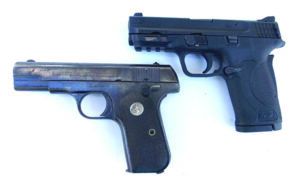
Loading the pistol for combat testing, we first used the Federal American Eagle 95-grain FMJs. The magazine was very easy to load, just as it was designed to be. We fired 100 rounds in each pistol at 5, 7, 10, and 15 yards. The raters added ammunition on their own time and dime as well because the pistol was so interesting. Hence, we had a higher-than-normal round count. Because there were only two magazines, we took turns loading and never had any difficulty or stubbed a finger. We really like the grip angle, the sights, and the trigger. A small handgun sometimes needs good sights more so than a full-size handgun because a shorter sight radius works against accuracy. We thought the Shield’s sights work well for both combat and precise shooting.
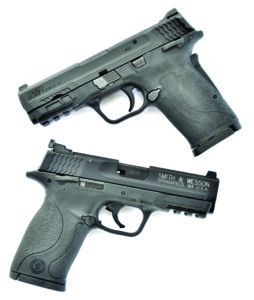
During the test, we racked the slide with only two fingers from time to time. The pistol works as designed. This pistol features a rail for a combat light, making it useful for home defense. We fired the pistol with four loads intended for personal defense. Results were good with these loads from Black Hills, Hornady, Remington, and Federal. Bullet weights from 60 to 102 grains functioned well and accuracy was excellent at a long 25 yards.
Our Team Said: We like the Smith & Wesson Shield 380. We are generally not comfortable with the power level and terminal ballistics of the 380 ACP; however, loads like the Black Hills Ammunition HoneyBadger and the Federal HST make the cartridge much more attractive than the previous choice of ball ammunition or a JHP that underpenetrates. The pistol is a joy to fire and use. It is more than accurate enough for personal defense. In fact, while we are not concerned with field and trail use, one of the raters noted it is accurate enough for small game as well, and the centerfire cartridge is far more reliable than rimfire ammunition, making the Shield a better choice for personal defense than any 22 LR rimfire pistol. In the accompanying specifications module, you’ll notice the grade there is an A-, which is a slight markdown for the round’s power, not the gun.
380 ACP/9mm Luger/30 Super Carry Performance Data
| Bullet Weight (Grains) | Chambering, Manufacturer, Brand, and Product Number | Average Velocity (fps) | Standard Deviation (fps) | Muzzle Energy (foot-pounds) | IPSC Power Factor | Average Accuracy (inches) | Expanded Width (inches) | Retained Weight (grains) | Retained Weight (percentage) | Penetration In Water (inches) | Gun Tests Grade |
|---|---|---|---|---|---|---|---|---|---|---|---|
| 60 | 380 ACP Black Hills HoneyBadger D380N420 | 1157 | 26 | 178 | 69 | 2.2 | 0.36 | 60 | 1 | 18 | A |
| 90 | 380 ACP Hornady Critical Defense FTX 90080 | 934 | 12 | 174 | 84 | 2.5 | 0.5 | 90 | 1 | 14 | A |
| 99 | 380 ACP Federal HST P380HST1S | 960 | 22 | 203 | 95 | 2.7 | 0.61 | 95 | 0.96 | 12 | A- |
| 102 | 380 ACP Remington Ultimate Defense 28964 | 899 | 30 | 183 | 92 | 1.9 | 0.59 | 100 | 0.98 | 15 | A |
| 115 | 9mm Luger Winchester Super-X X9MMSHP | 1180 | 14 | 356 | 136 | 1.7 | 0.82 | 115 | 1 | 12 | A |
| 124 | 9mm Luger Hornady American Gunner XTP +P 90224 | 1214 | 14 | 406 | 150 | 2.4 | 0.54 | 122 | 0.99 | 20 | A |
| 147 | 9mm Luger Remington Golden Saber Bonded GSB9MMC | 1030 | 11 | 346 | 151 | 2.2 | 0.58 | 147 | 1 | 18 | A |
| 100 | 30 Super Carry Remington JHP R20019 | 1202 | 18 | 321 | 120 | 2.5 | 0.52 | 100 | 1 | 20 | A |
| 100 | 30 Super Carry Federal HST P30HST1S | 1206 | 7 | 323 | 120 | 1.9 | 0.55 | 100 | 1 | 20 | A |
| 115 | 30 Super Carry Speer Gold Dot 242261GD | 1105 | 12 | 312 |
Value Guide: 380 ACP Semi-Auto Pistols
| Gun Name | Issue | Grade | Comments |
|---|---|---|---|
| CZ 83 380 ACP, $330 | Jan. 2022 | A | Did not suffer any type of stoppage. It was reliable, well made, and perhaps even overbuilt. |
| Bersa 380 Thunder Plus THUN380PM15 380 ACP, $352 | Jan. 2022 | A- | Best Buy. Carries on for the affordable Bersa Thunder. Never failed to feed, chamber, fire or eject. |
| Tisas Fatih B380 F380B 380 ACP, $434 | Jan. 2022 | B | An attractive pistol with good fit and finish and good accuracy. It also fired high, which isn’t easy to fix. |
| Glock 42 UI4250201 380 ACP, $360 | Nov. 2020 | A- | Best Buy. The Glock 42 handled well and offered the best accuracy of the test. |
| Colt Government Model MK IV Series 80 380 ACP, $400 | Nov. 2020 | A- | Because of the Glock’s availability as a current product, we would pick the Glock before the Colt MK IV. |
| Ruger LCP II No. 3792 380 ACP, $300 | Nov. 2020 | B | The Ruger LCP II is reliable, reasonably accurate for short-range use, and not difficult to control. |
| NAA Guardian 380 ACP, $350 | Nov. 2020 | C- | This NAA was well made, and its fit and polish were good. Accuracy was poor even for a pocket pistol. |
| S&W M&P 380 Shield EZ 180023 380 ACP, $384 | Aug. 2018 | A | The Shield is EZ-ily among the most useful and attractive 380 ACP pistols we have tested. |
| Springfield 911 Bi-Tone PG9109S 380 ACP, $559 | Aug. 2018 | A | The Springfield 911 is suited to carrying hammer down instead of cocked and locked. |
| Walther PPK/S 4796006 380 ACP, $700 | Aug. 2018 | C | Not reliable with a modern load designed to maximize the cartridge. We would not buy the Walther PPK/S. |
| Rock Island Armory Baby Rock 51912 380 ACP, $356 | Aug. 2016 | A | Combat shooting with the Baby Rock gave good results. Accuracy was excellent for a pistol this size. |
| Ruger LCP 3701 380 ACP, $229 | Aug. 2016 | B+ | We would pay more for the LCP Custom, which has better sights and trigger. |
| Remington RM380 Micro 96454 380 ACP, $341 | Aug. 2016 | B- | Heavy stacking of the trigger led to poor accuracy. The RM380’s sight regulation was also badly off. |
| Ruger LCP-C Custom No. 3740 380 ACP, $419 | Oct. 2015 | A | The Ruger’s sights and trigger are great improvements over previous versions of the LCP. |
| Taurus Curve 180CRVL #1-180031L 380 ACP, $380 | Oct. 2015 | C | The bottom line is that a pistol without sights isn’t useful, in our opinion. Pass on the Curve. |
| Kimber Micro Carry Advocate 380 ACP, $796 | Sep. 2015 | A | The Kimber was well finished and demonstrated excellent reliability and accuracy. |
| Browning Black Label 1911-380 051904492 380 ACP, $620 | Sep. 2015 | B | The Browning is a reliable handgun with familiar operation. Less accurate than the smaller Kimber. |
| Glock 42 380 ACP Subcompact Slimline, $480 | Nov. 2014 | B | With a Viridian green laser on it, we’d bump up the Glock 42’s grade to an A- and probably buy it. |
| Kahr CW 380 No. 3833 380 ACP, $419 | Nov. 2014 | B | We didn’t like the Kahr’s sights, the short grip, or the long DAO trigger pull. |
| Colt Mustang XSP Pocketlite O6790 380 ACP, $649 | Nov. 2014 | C+ | The XSP costs a lot of money, and there are many pistols that work better for less money. |
| SIG Sauer P238 238-380-NBS12 380 ACP, $710 | Nov. 2014 | C | Its controls should have produced a 1911-like feel, but the P238’s inconsistent trigger pull affected accuracy. |
Value Guide: 9mm Luger Handgun Rankings
| Gun Name | Issue | Grade | Comments |
|---|---|---|---|
| Springfield Armory SA-35 9mm Luger, $699 | May. 2022 | A | Best Buy. The SA-35 is less expensive, has a better trigger, better sights, and is completely modern. |
| Browning P35 Hi-Power 9mm Luger, ~$1000 | May. 2022 | B+ | If you want a great historical firearm to collect and shoot, then the Hi-Power is your only choice. |
| Langdon Tactical LTT Beretta 92X 9mm Luger, $1184 | Feb. 2022 | A | Best Buy. Trigger action is superb, and all parts fit correctly. Accuracy is excellent. |
| Kriss Sphinx SDP Compact 9mm Luger, $999 | Feb. 2022 | A- | A great-handling pistol, accurate, reliable, and with a good trigger action. |
| SIG Sauer P229 Elite-Compact E29R-9-BSE 9mm Luger, $1313 | Feb. 2022 | A- | With aftermarket night sights and a flat trigger option, we upgraded the pistol into a superior performer. |
| SIG Sauer P365 365-9-BXR3 9mm Luger, $599 | Dec. 2021 | A | Our Pick. Small enough to fit in a pants pocket. Carries 10+1. Felt recoil is less than with a 38 Sp. |
| Ruger MAX-9 No. 3500 9mm Luger, $544 | Sep. 2021 | A | Our Pick. This is a sophisticated pistol. No fault with the magazines, capacity, or general accuracy. |
| Smith & Wesson M&P9 Shield Plus 13246 9mm Luger, $553 | Sep. 2021 | A | A step up from a previously 9mm Shield. The new pistol has an improved trigger and greater capacity. |
| Taurus GX4 1-GX4M931 9mm Luger, $398 | Sep. 2021 | A- | Best Buy. The Taurus is the most compact, and the Taurus is the only pistol with a changeable backstrap. |
| Guncrafter Industries Exec.CZ 75B 9mm Luger, $1875 | Aug. 2021 | A | The Executive is among the most eye-catching, attractive, and well-finished pistols we have tested. |
| Beretta/Wilson Combat 92G Centurion 9mm Luger, $1250 | Aug. 2021 | A | The Wilson Combat gun is a top choice for tactical and service use. Comes with light rail, 20-round mag. |
| Browning Hi-Power 9mm Luger, $1860 | Aug. 2021 | B | Compared to the more modern pistols, the Hi-Power simply isn’t practical. |
| CZ-USA CZ 75B Omega 91235 9mm Luger, $631 | Aug. 2021 | B | Reliable, accurate, ambidextrous safety, an 18-round magazine, good sights, and is suppressor ready. |
| Ruger SR1911 6722 9mm Luger, $775 | June. 2021 | A | Our Pick. The most expensive gun tested. We liked the fit, finish, handling and accuracy. |
| Tisas Regent BR9 9mm Luger, $558 | June. 2021 | A- | We like this Tisas rendition. Downside: The cocking effort is severe, which may disqualify it for some. |
| Citadel M1911A1-CS CIT9MMCSP 9mm Luger, $479 | June. 2021 | B | Best Buy. Reliable and handles well. Less accuracy than the other pistols. Front sight is too gray. |
| Zenith Tisas ZIG PCS9 9mm Luger, $549 | June. 2021 | D | Downsides: Extractor problems and the slide-lock safety wasn’t properly fitted. |
| Shadow Systems MR920 9mm Luger, $799 | Apr. 2021 | A | Our Pick. The Shadow Systems Multi Role (MR) pistol is basically an improved Glock 19. Excellent buy. |
| Sarsilmaz SAR9 9mm Luger, $400 | Apr. 2021 | A- | Best Buy. Many good features. We would have liked a lighter trigger action. |
| Tisas Zigana PX-9 9mm Luger, $330 | Apr. 2021 | B | Reliable. Will appeal to those who like the Springfield XD-9. The primary drawback is a heavy trigger. |
| Ruger American Pro Duty 10 08607 9mm Luger, $579 | Feb. 2021 | A | Our Pick. $100 more than the others, but it was the most accurate pistol and had surprisingly light recoil. |


























